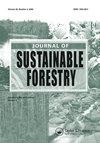The Impact of Invasive Buckthorn on Ecosystem Services and its Potential for Bioenergy Production: A review
IF 1.8
4区 农林科学
Q3 FORESTRY
引用次数: 2
Abstract
ABSTRACT Two species of invasive shrubs are causing extensive environmental harm across North America. Common buckthorn (Rhamnus cathartica L.) and glossy buckthorn (Frangula alnus P. Mill.), originally imported from Europe, have become naturalized in many different ecosystems and are causing negative effects on associated ecosystem services. These invasive plants often create dense, monotypic stands that out-compete native plant species for nutrients and light. Current control methods, including manual or mechanical removal, are expensive and are mainly limited to destroying the buckthorn on site. The high cost of removal may be a barrier for restoration. Economic valuation should be carried out in terms of ecosystems services to better understand the cost-benefit of removing buckthorn. A cost-effective solution for removing buckthorn should also be explored. In this review, the state of the knowledge on the effects of buckthorn and its cost associated with major ecosystem services were synthesized. Existing methods to harvest and transport buckthorn and potential new methods were compiled. Finally, a policy review of buckthorn was completed for states where buckthorn is most prevalent. Findings from this review will be important for applying an economic cost to buckthorn and revealing where more work can be done.入侵沙棘对生态系统服务的影响及其生物能源生产潜力综述
摘要两种入侵灌木正在北美造成广泛的环境危害。原产于欧洲的普通沙棘(Rhamnus cathatica L.)和光滑沙棘(Frangula alnus P.Mill.)已在许多不同的生态系统中归化,并对相关的生态系统服务产生负面影响。这些入侵植物通常会形成密集的单型林分,在营养和光照方面与当地植物物种竞争。目前的控制方法,包括手动或机械清除,成本高昂,主要局限于现场销毁沙棘。移除的高成本可能是修复的障碍。应该从生态系统服务的角度进行经济评估,以更好地了解去除沙棘的成本效益。还应探索一种具有成本效益的去除沙棘的解决方案。在这篇综述中,综合了有关沙棘的影响及其与主要生态系统服务相关的成本的知识现状。汇编了现有的沙棘收获和运输方法以及潜在的新方法。最后,对沙棘最流行的州进行了政策审查。这项审查的结果对于将经济成本应用于沙棘并揭示哪里可以做更多的工作至关重要。
本文章由计算机程序翻译,如有差异,请以英文原文为准。
求助全文
约1分钟内获得全文
求助全文
来源期刊

Journal of Sustainable Forestry
Social Sciences-Geography, Planning and Development
CiteScore
3.90
自引率
12.50%
发文量
42
期刊介绍:
Journal of Sustainable Forestry publishes peer-reviewed, original research on forest science. While the emphasis is on sustainable use of forest products and services, the journal covers a wide range of topics from the underlying biology and ecology of forests to the social, economic and policy aspects of forestry. Short communications and review papers that provide a clear theoretical, conceptual or methodological contribution to the existing literature are also included in the journal.
Common topics covered in the Journal of Sustainable Forestry include:
• Ecology, management, recreation, restoration and silvicultural systems of all forest types, including urban forests
• All aspects of forest biology, including ecophysiology, entomology, pathology, genetics, tree breeding, and biotechnology
• Wood properties, forest biomass, bioenergy, and carbon sequestration
• Simulation modeling, inventory, quantitative methods, and remote sensing
• Environmental pollution, fire and climate change impacts, and adaptation and mitigation in forests
• Forest engineering, economics, human dimensions, natural resource policy, and planning
Journal of Sustainable Forestry provides an international forum for dialogue between research scientists, forest managers, economists and policy and decision makers who share the common vision of the sustainable use of natural resources.
 求助内容:
求助内容: 应助结果提醒方式:
应助结果提醒方式:


